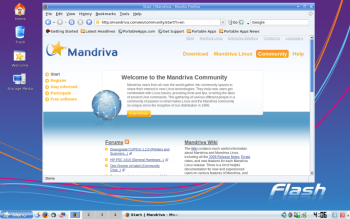Author: Dmitri Popov
Mandriva is the only Linux maker that offers a version of its distribution packaged with and designed to run off a USB stick. True, you can install virtually any Linux distro onto an external USB device, but Mandriva Flash 2008 offers you a complete solution, including a USB stick with pre-installed version of Mandriva Linux and a CD containing a few useful tools. It’s a worthwhile package, though not without room for improvement.
The first version of Mandriva Flash came on a 2GB USB stick and was based on Mandriva Linux 2007. This month’s new release doubles the size of the stick and offers the latest Mandriva Linux 2008. The USB stick comes with a five-year warranty and is produced by Dane-Elec, a major European flash memory manufacturer. This means that you will probably be paying a premium for the high-quality stick, but it’s unlikely to fail on you after a few weeks of use.
If your computer supports booting from USB devices, making it work with Mandriva Flash is easy. In your computer’s BIOS, set USB as the first boot device, plug in the Mandriva Flash drive, and reboot your machine. For users who don’t know how to access and change BIOS’s settings, Mandriva offers a detailed guide.
If you have an older machine that doesn’t support USB boot, you have two options. In the doc folder on the Mandriva Flash stick you will find a boot.iso image. You can use it to burn a CD that can boot your machine into Mandriva Flash. While using the CD will help you to kickstart Mandriva Flash on virtually any machine with a USB port, it’s hardly the most elegant solution. Realizing that, Mandriva has added a new feature called ezBoot. When you insert the Mandriva Flash stick while you are in Windows, a simple launcher offers you several options, including booting into Mandriva Flash. When you choose it, the launcher installs what seems to be a minimal bootloader, so when you reboot the machine, you have a choice of starting the original system or Mandriva Flash. This is a clever hack, but it has one huge drawback: it leaves the bootloader on the host machine. While that may not be a big problem if you are using Mandriva Flash on your own computer, it rules out using it on any public machine. Imagine the reaction of the library staff, if after you’ve used one of the their computers, it no longer boots directly into Windows, but instead displays a black screen with a couple of mysterious options. A simple tool that removes the bootloader would have been handy.
Speaking of Windows, Mandriva Flash comes with a portable version of Mozilla Firefox and Thunderbird, so even if you can’t boot into Linux, you can still check your email and use the Web with applications customized with your personal settings. Better yet, Mandriva Flash uses shared profiles for both applications, so when you switch to the Linux side of the stick, all your email messages, history, and bookmarks are still there.
The Mandriva Flash distro itself is pretty much the same as Mandriva Linux 2008. When you boot Mandriva Flash for the first time, you are guided through the configuration process, which is similar to the installation procedure of the desktop version of Mandriva Linux. You have to specify things like location, time zone, and root password, as well as create a new user and decide whether you want to use a 3-D desktop. Like Mandriva Linux 2008, the Flash version comes with two 3-D desktops: Metisse and Compiz. During the setup process, you are also prompted to choose how much space on the stick you want to allocate for the system. The default value is 400MB, but you can allocate more if you, for example, plan to install additional applications. This, of course, leaves less space for your files and documents. Once the system is configured, it acts as a conventional Mandriva Linux desktop.
Mandriva also offers a rescue CD that allows you to reset the root or user password, make a backup of Mandriva Flash, perform a restore from any of the last 10 backups, test the USB stick for errors, and restore Mandriva Flash to the factory settings. This can help you to avoid data loss and help keep your stick in perfect form — when it works properly. In my tests, the CD wouldn’t recognize the inserted stick, which rendered the tools useless.
Verdict
While several other distros are designed specifically to run off external USB drives, Mandriva Flash still offers a good alternative worth paying for. First of all, you don’t have to get your hands dirty installing a Linux distro on a USB stick and spend time configuring it. Unlike other distros, Mandriva Flash offers a full-featured desktop with all the frills and fancy trimmings, including 3-D desktop effects. There is, however, room for improvement. The ezBoot feature needs an uninstaller to be of real use, while the Rescue CD should address the existing quirk with recognizing the stick.
Categories:
- Mandriva
- Reviews
- Linux
- Distributions




